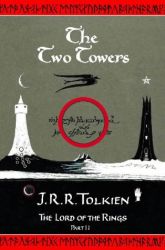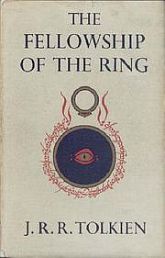The Return of the King is probably the volume of J.R.R. Tolkien’s trilogy that I remembered the least.
It’s also the book that differs the most from Peter Jackson’s film treatment. But Return of the King has always been my least favorite of the three movies, and many of the wonderful moments in that film — the lighting of the beacons, Faramir’s charge on Osgiliath, the catapult battle, Pippin and Gandalf’s discussion about the afterlife — are scenes that Jackson either invented or wildly embellished. (Unfortunately, PJ also invented Sam and Frodo’s falling out over some missing lembas wafers. Ugh.)
 So there were all kinds of gems awaiting me on my re-reading of ROTK. I had completely forgotten about Beregond, Guard of the Citadel, and the heroic role he plays in saving Faramir from death at the hands of Denethor. I had only a faint recollection of Ghân-buri-Ghân and the Wild Men. I didn’t recall that our heroes have a run-in with Saruman before the Hobbits return to the Shire. I had forgotten that the only reason Merry was able to wound the Lord of the Nazgûl was because of his sword, picked up at the Barrow-downs in the early chapters of Fellowship.
So there were all kinds of gems awaiting me on my re-reading of ROTK. I had completely forgotten about Beregond, Guard of the Citadel, and the heroic role he plays in saving Faramir from death at the hands of Denethor. I had only a faint recollection of Ghân-buri-Ghân and the Wild Men. I didn’t recall that our heroes have a run-in with Saruman before the Hobbits return to the Shire. I had forgotten that the only reason Merry was able to wound the Lord of the Nazgûl was because of his sword, picked up at the Barrow-downs in the early chapters of Fellowship.
The first half of the book (book 5 of the Lord of the Rings proper) has simply masterful pacing. The way the tension builds throughout the siege of Gondor… and then Gandalf confronts the Lord of the Nazgûl… and then suddenly the horns of the Rohirrim blow… and then we backtrack to see the ride of the Rohirrim… oh man, is that good. It’s the big build-up that was sorely lacking before the battle of Helm’s Deep in Two Towers.
A single theme kept running through my head as I read Return of the King. It’s the way evil acts continually redound to the greater good in the end. Think of how Merry found his sword. The Hobbits’ capture by the wights in the Barrow-downs certainly seemed like a bad turn when it happened; but this serendipitous encounter enables Merry to critically wound the Nazgûl at just the right time, thus possibly saving the entire battle from going sour and changing the fate of all Middle Earth.
But nothing’s that cut and dried in Return of the King. There’s an unsettling kind of moral determinism lurking behind the scenes here, and indeed throughout the entire trilogy. Perhaps “moral determinism” is the wrong thing to call it, but I can’t think of a better phrase to use. It’s this pervasive sense that not only does the darkness exist, but it’s actually necessary and an integral component to the light.
Why do I think that? Because it seems like Tolkien is constantly giving us matched pairs of characters, one of whom turns to the path of light and one of whom follows the path of darkness.
Take for example the characters of Denethor and Théoden, the Steward of Gondor and the King of Rohan. Clearly Tolkien means to draw very strong parallels between the two. Notice the similarities:
- Both are rulers of their respective lands (Gondor and Rohan)
- Both have recently lost firstborn sons in battle (Boromir and Théodred)
- Both have ambivalent feelings about their remaining heirs (Faramir and Éomer)
- Both are confronted with a devastating siege (Minas Tirith and Helm’s Deep)
- Both have been striving against an insidious higher power (Sauron and Saruman)
- Both take on a Hobbit squire (Pippin and Merry)
- Both men had fathers for whom Aragorn fought in his youth (Ecthelion and Thengel)
- Both are initially mistrustful of Gandalf
- Both eventually grant Gandalf favors early in the saga (access to the Gondorian archives and the loan of Shadowfax)
- Both die in The Return of the King
But obviously there’s a crucial difference between the two; one selflessly redeems himself and dies in battle, while the other stews in his bitterness until he finally commits suicide.
 It’s a difficult book. Frodo and Sam, the characters we’re most invested in, disappear for a couple hundred pages; Gandalf is presumably dead in the book’s opening chapters; Boromir’s definitely dead; and Aragorn is still something of a distant figure. Gimli is interesting enough but hardly crucial to the plot, and it’s difficult to give two figs about Legolas.
It’s a difficult book. Frodo and Sam, the characters we’re most invested in, disappear for a couple hundred pages; Gandalf is presumably dead in the book’s opening chapters; Boromir’s definitely dead; and Aragorn is still something of a distant figure. Gimli is interesting enough but hardly crucial to the plot, and it’s difficult to give two figs about Legolas. But more importantly, in an ideal world one would be able to discuss The Fellowship of the Ring without being overshadowed by Peter Jackson’s film of the same name. Unfortunately, for me that’s impossible. I’ve seen the films probably a dozen times each since their release, enough that I can recite most of the dialogue word for word. The Extended Edition of Fellowship is one of my favorite films ever, ever, ever.
But more importantly, in an ideal world one would be able to discuss The Fellowship of the Ring without being overshadowed by Peter Jackson’s film of the same name. Unfortunately, for me that’s impossible. I’ve seen the films probably a dozen times each since their release, enough that I can recite most of the dialogue word for word. The Extended Edition of Fellowship is one of my favorite films ever, ever, ever. If you’re going to read the complete works of Tolkien properly, you definitely should not follow The Silmarillion with The Hobbit. (
If you’re going to read the complete works of Tolkien properly, you definitely should not follow The Silmarillion with The Hobbit. (